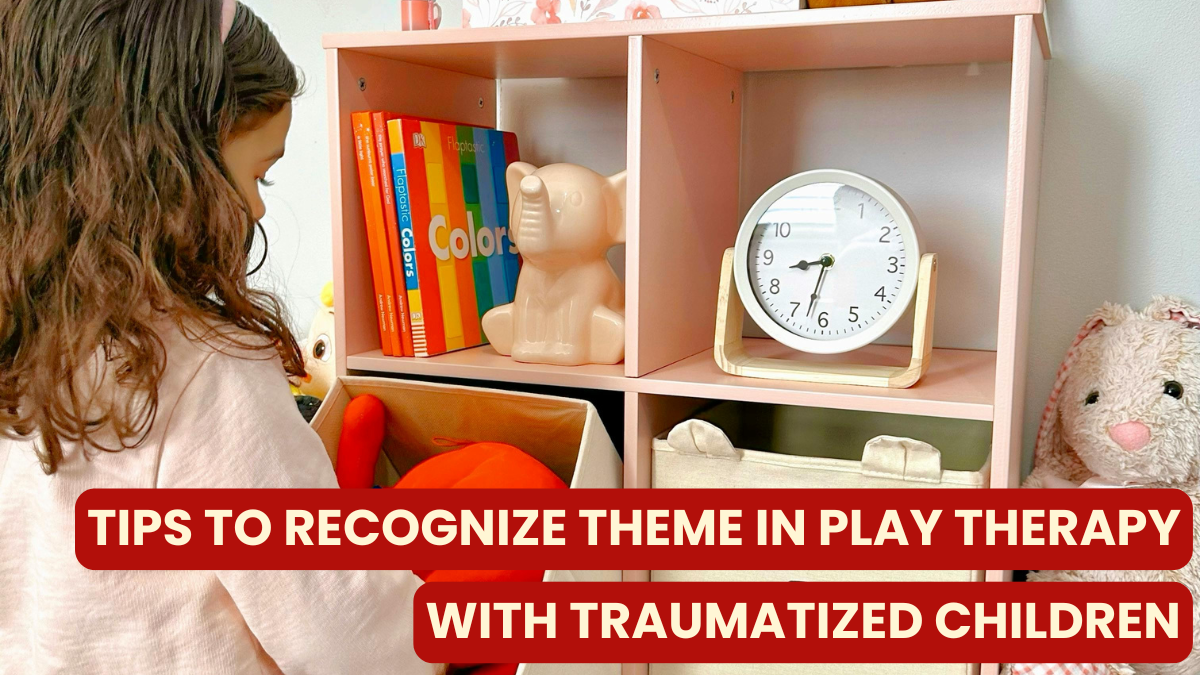Tips to Recognize Themes in Play Therapy with Traumatized Children

When working with children who have experienced trauma, recognizing the themes that emerge during play therapy sessions can provide essential insight into their inner world. Play themes offer a window into how children process, integrate, and begin to heal from traumatic experiences—especially when words alone are not enough.
In this blog, we’ll explore:
-
What play themes are and why they matter
-
The subjective nature of identifying themes
-
Common trauma-related play themes
-
How to apply this insight using a play therapy model
Why Play Themes Matter in Trauma Work
Play therapy offers children a free and protected space to express complex feelings and experiences using symbolic language. For children who’ve experienced trauma, this symbolic play often includes reenactments, emotional metaphors, and relational dynamics that reflect their distress.
Themes in play therapy help therapists:
-
Understand what’s happening in sessions
-
Identify where the child is in the healing process
-
Make informed clinical decisions
-
Engage parents or caregivers appropriately
The ability to identify themes also helps therapists stay grounded in a treatment model—especially when progress seems unclear.
Interpreting Themes: A Subjective and Projective Process
It’s important to remember: identifying play themes is a subjective process. Play is symbolic and often projective. Just like therapists listen for tone, inflection, and body language in talk therapy, play therapists “listen” to the play itself—what’s chosen, how it’s used, what’s repeated, and how emotions are expressed or avoided.
Your theoretical model provides the framework for interpreting what you observe. Whether you’re using Child-Centered Play Therapy, an integrative approach, or trauma-specific frameworks rooted in neuroscience and attachment, your model helps you understand what the play might be communicating and how to respond therapeutically.
Common Play Themes in Trauma Work
Here are eight common play themes you may observe when working with children who have experienced trauma. These themes are not exclusive to trauma, but when viewed through a trauma-informed lens, they can offer valuable information about your client’s internal experience.
1. Reenactment of Traumatic Events
Children may repeatedly act out scenarios that closely resemble their traumatic experience. Play offers a symbolic distance that feels safer than direct discussion. These reenactments can be raw and emotionally intense, and the therapist’s role is to create a safe container using a grounded model.
2. Power and Control
Themes of dominance, control, and reversing roles often emerge. This is particularly common in children who felt powerless during their trauma. They may assert control over play materials, over you as the therapist, or within the storylines they create. These expressions aren’t just behavioral—they’re a form of emotional regulation and meaning-making.
3. Rescue and Heroism
Children may introduce rescuers or superheroes to save characters in danger. Sometimes they place themselves in the hero role; other times they may cast you or another figure in that role. These themes often reflect the child’s wish for safety, intervention, or protection that may have been missing during their trauma.
4. Isolation and Withdrawal
Trauma can make children feel different, misunderstood, and alone. In play therapy, this may look like solitary play, characters being left out or abandoned, or narratives where the central figure is cut off from others. These expressions may signal a need for connection and validation.
5. Persecution and Victimization
Children may create villains or persecutors that harm others or seek control through fear. These themes can mirror the child’s own feelings of being targeted or harmed, and their internal struggle to make sense of injustice, fear, and confusion.
6. Regressive Play
Children may revert to an earlier developmental stage, engaging in baby play, wanting to be nurtured, or using baby voices. This can indicate a desire to reclaim missed stages of care and attachment—particularly common in cases involving neglect or disrupted caregiving relationships.
7. Fragmented or Disorganized Play
This theme often presents as chaotic, unfocused, or disconnected play. There may be difficulty sustaining a storyline or settling into a cohesive narrative. It could reflect a dysregulated nervous system or unresolved trauma that’s overwhelming the child’s ability to focus or organize their internal world.
Note: Fragmented play may also appear in children with ADHD or other neurodevelopmental concerns. Always consider the full clinical picture.
8. Safety and Protection
Children might create forts, hide characters, or build protective structures. These actions symbolize a need to restore a sense of safety and predictability. These themes are particularly powerful when viewed as efforts to regain internal control and emotional regulation.
Applying a Theoretical Model: Why It Matters
While play themes offer valuable insights, they are just one part of the therapeutic process. Interpretation without a grounded model can lead to confusion or misdirection. Using a trauma-informed play therapy framework—whether it's Child-Centered, Adlerian, or an integrative model—helps you:
-
Know when to intervene or observe
-
Determine how to respond to specific play behaviors
-
Track progress across sessions
-
Understand how trauma is being expressed and transformed
At times, the play may not “make sense.” That’s okay. Trust the process. The child is using play to communicate and reorganize their inner world—even if the full picture isn’t clear yet.
Final Thoughts
Recognizing play therapy themes is a powerful tool when working with children who've experienced trauma. It helps therapists attune more deeply, track progress, and guide intervention. But always remember—play is complex, and interpretation requires humility, curiosity, and a commitment to a sound clinical framework.
By anchoring your observations in a solid play therapy model and trusting the child’s natural capacity to move toward healing, you create a space where real transformation can happen.
Categories: : Neuroscience of attachment, Play Therapy, Play Therapy Model, Play Therapy Themes, Podcast, Trauma
 Cathi Spooner
Cathi Spooner 
